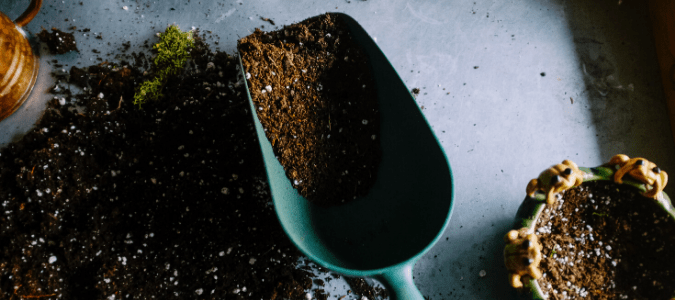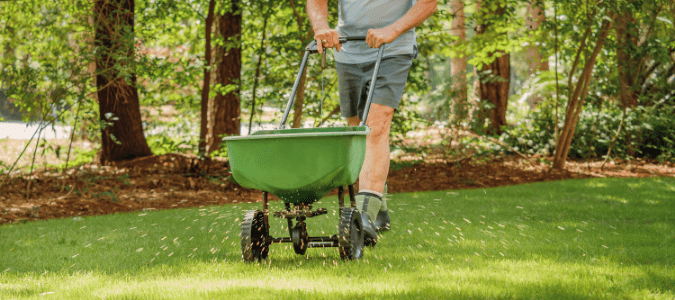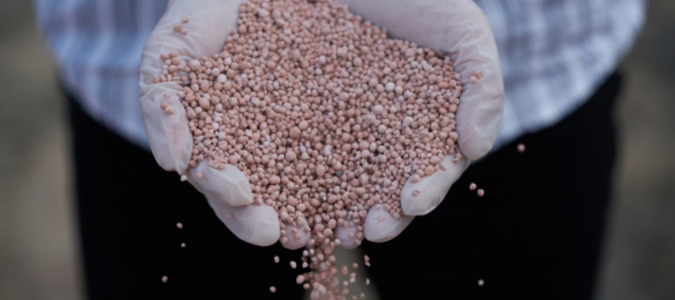Should you fertilize your lawn in the fall? The answer is yes; however, when you start the process is important. You want to ensure that you nourish your lawn before the cooler temperatures set in so that your lawn can make a strong spring comeback.
Next, it’s easy to accidentally over-fertilize your lawn. Luckily there are ways to reverse over-fertilization, and it starts with understanding the signals your lawn sends you that you used too much fertilizer.
Finally, this guide will break down the difference between organic and inorganic fertilizers. Keep reading to learn which type is best for your lawn.
When to Fertilize Your Lawn in the Fall
Even though the leaves change colors and vegetation starts to go dormant in the fall, it is still an active growing time for your grass. It’s important not to skip your fall fertilization because it prepares your lawn to return lush and beautiful in the springtime.
Warm-season grasses require fertilization in the fall. It helps the grass survive the winter and return stronger in the spring. Warm-season grass species include bermuda grass, zoysia grass and St. Augustine grass. Each of these species enters an active growth season as temperatures start to cool off.
The best time to fertilize your warm-season grass is at the beginning of the fall season. The fertilizer will help the grass establish robust root systems, absorb important nutrients and promote overall plant health.
If you skip the fall fertilization, your grass will be less winter-resistant and can experience stress through the colder months. In addition, it will not have a strong comeback in the spring. Fertilizing in the fall can save you time and money spent on bringing dead grass back to life.
August through September is the best time to fertilize your warm-season grass before temperatures drop. It is still warm enough to give your grass time to absorb all essential nutrients from the fertilizer before the cooler temperatures set in.
Fertilizing too late in the fall season can lead to too much top growth, which pulls energy out of the root system development process. If you are unsure about the best time to fertilize your lawn in the fall, contact a lawn care specialist for your lawn fertilization needs.
How Much Fertilizer to Apply in the Fall
A general rule for fertilizing warm-season grasses in the fall is to apply one-half to one pound of nitrogen per 1,000 square feet of lawn. The nitrogen content is the most important component of lawn fertilizer as it promotes healthy leaf and root growth.
To determine how much fertilizer you should use for your lawn, you’ll need to know the nitrogen content of your fertilizer. This information and the recommended application rates are usually indicated on the packaging.
For example, a 10-10-10 fertilizer contains 10% nitrogen, 10% phosphorus, and 10% potassium. If you want to apply one pound of nitrogen per 1,000 square feet, you’ll need to apply ten pounds of the 10-10-10 fertilizer per 1,000 square feet.
The Right Number of Fall Fertilizer Applications
The amount of times you’ll need to apply fertilizer in the fall will vary based on your lawn’s needs. However, most homeowners apply four rounds of fertilizer to warm-season grass in the fall.
It’s best to space fertilizer applications out every four to six weeks. Applying the right amount at the correct intervals will ensure that your grass receives a steady supply of nutrients without risking over-fertilization.
It’s best to contact a lawn care specialist for guidance on when and how often to fertilize your lawn and how much fertilizer to apply each time.
Signs of Over-Fertilization
Over-fertilization occurs when homeowners apply too much fertilizer or apply rounds of fertilizer too close together. Unfortunately, over-fertilization can harm and kill the grass. The good news is that there are ways to stop the damaging effects of over-fertilization and reverse it so that your lawn can remain lush and green.
The first step is to understand the signs of over-fertilization. For example, if your lawn appears yellow or brown, it could be due to too much fertilizer, also known as “fertilizer burn.” Discoloration occurs when your lawn experiences a nitrogen overdose, most noticeable on the tips of the grass blades.
Next, your grass may wilt due to over-fertilization, even if your lawn gets plenty of water. Fertilizer dehydrates grass, so too much can cause your lawn to lose water and wilt rapidly.
On the other hand, over-fertilization can also lead to too much growth. While it might seem good that your grass grows very quickly, it will not be strong enough to withstand diseases. Slower growth ensures the roots have plenty of time to establish themselves, which helps your grass maintain healthy nutrient levels.
Another sign of over-fertilization is thatch buildup, the layer of dead grass and roots on top of the live grass. When thatch accumulates, it prevents water and nutrients from absorbing into your lawn.
Finally, over-fertilization can cause weed and pest problems. If you notice any of these signs of over-fertilization, contact a lawn care specialist to discuss options to reverse the damage.
How To Reverse Over-Fertilization
There are several things you can do to attempt to reverse over-fertilization. Remember that working with a lawn care specialist will guarantee the best results.
First, try to remove all visible excess fertilizer with a rake. Sweep the fertilizer off the grass gently to avoid damaging the grass further. Next, you can try to flush the fertilizer out of your lawn with water. Watering your lawn generously will dilute the fertilizer and remove excess nutrients.
Over-fertilization may occur because the nutrients cannot absorb into the roots. If so, aerating your lawn can loosen soil compaction and improve nutrient absorption.
Lastly, watering and mowing your lawn regularly can help reverse over-fertilization. Proper watering will help the grass recover, and mowing will encourage healthy grass growth and minimize stress on your lawn.
Working with a professional lawn care service is the best way to reverse over-fertilization. The experts can get your lawn looking beautiful again and advise you on how to fertilize your lawn to avoid over-fertilizing in the future.
What’s the Difference Between Organic Versus Inorganic Fertilizers?
Choosing the right fertilizer for your lawn is an important step in lawn maintenance. Homeowners often get confused about organic versus inorganic fertilizers and which option is right for their lawn.
The main difference between the two types of fertilizer is in what materials they are made of and how they are made. For example, organic fertilizer is made of organic materials, such as living organisms or their byproducts. Compost, manure, bone meal, fish emulsion and seaweed are common ingredients.
Organic fertilizer is also minimally processed. The pros of using organic fertilizer include slow-release nutrient absorption and potential soil improvement. It is also a more eco-friendly choice and can help keep the land fertile for the long term.
The primary cons of using organic fertilizer is nutrient variability. Since it is made of organic materials, it’s impossible to ensure consistent nutrient ratios, making it hard to determine how much your lawn needs.
Organic fertilizer is best to use during growing seasons to provide your lawn with continuous slow-release nutrients. It can also help improve soil and nurture a diverse ecosystem.
Inorganic fertilizer is made of synthetic materials with additional minerals added during processing. The pros of using synthetic fertilizer are that it offers precise nutrient control and consistency each time. It also delivers nutrients quickly and is easier to store than organic fertilizer since it’s more compact.
The cons of using inorganic fertilizer include the risk of over-fertilization, soil degradation and other climate concerns.
The best time to use inorganic fertilizer is when you want to see quick results. It can help with plant establishments, nutrient deficiencies and supplementation.
Nurture Your Lawn With Fall Fertilization
Correctly fertilizing your lawn in the fall is one of the best ways to ensure it will grow back strong and lush in the springtime. It will also help you avoid over-fertilization.
If you still have questions about when to fertilize your lawn in the fall, the different types of fertilizer, how many applications to use and how to space them out, contact a lawn care specialist. A lawn care specialist can handle all aspects of your lawn care.
ABC Can Keep Your Lawn Healthy and Green
Taking care of your grass can take a lot of work. If you would rather spend your weekend enjoying your yard, contact ABC Home & Commercial Services. Our lawn care team can give you that healthy green grass you’ve been looking for. We even have a team who can refresh your landscaping!



